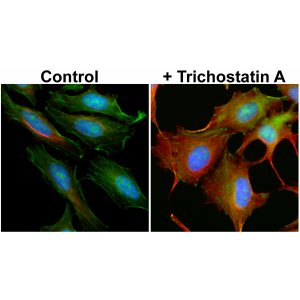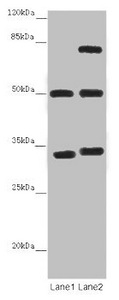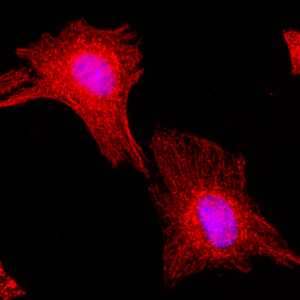
Immunocytochemistry of HeLa cells non-treated or treated with Trichostatin A (TSA), using anti-Acetyl- alpha-Tubulin (Lys40) rabbit monoclonal antibody (Clone RM318) at a 1:5000 dilution (red). Actin filaments have been labeled with fluorescein phalloidin
anti-Acetyl-alpha-Tubulin (Lys40), Rabbit Monoclonal (RM318)
REV-31-1204-00
ApplicationsWestern Blot, ImmunoCytoChemistry
Product group Antibodies
TargetTUBA1B
Overview
- SupplierRevMAb Biosciences
- Product Nameanti-Acetyl-alpha-Tubulin (Lys40), Rabbit Monoclonal (RM318)
- Delivery Days Customer10
- ApplicationsWestern Blot, ImmunoCytoChemistry
- CertificationResearch Use Only
- ClonalityMonoclonal
- Clone IDRM318
- Gene ID10376
- Target nameTUBA1B
- Target descriptiontubulin alpha 1b
- Target synonymsK-ALPHA-1, tubulin alpha-1B chain, alpha tubulin, alpha-tubulin ubiquitous, tubulin K-alpha-1, tubulin alpha-ubiquitous chain, tubulin, alpha, ubiquitous
- HostRabbit
- IsotypeIgG
- Protein IDP68363
- Protein NameTubulin alpha-1B chain
- Scientific DescriptionMicrotubules are key elements of the eukaryotic cytoskeleton that dynamically assemble from heterodimers of alpha- and beta-tubulin. Two different mechanisms can generate microtubule diversity: the expression of different alpha- and beta-tubulin genes, referred to as tubulin isotypes, and the generation of posttranslational modifications (PTMs) on alpha- and beta-tubulin. Tubulin PTMs include the well-known acetylation or phosphorylation, and others that have so far mostly been found on tubulin, detyrosination/tyrosination, polyglutamylation and polyglycylation. These PTMs might have evolved to specifically regulate tubulin and microtubule functions. Tubulin acetylation was discovered on K40 of flagellar alpha-tubulin in Chlamydomonas reinhardtii and is generally enriched on stable microtubules in cells. It is located on the microtubule lumenal surface. As a result of its localization at the inner face of microtubules, K40 acetylation might rather affect the binding of microtubule inner proteins, a poorly characterized family of proteins. Functional experiments in cells have further suggested that K40 acetylation regulates intracellular transport by regulating the traffic of kinesin motors probably by indirect mechanisms. Acetyltransferase alpha-Tat1 (or Mec-17) specifically acetylate alpha-tubulin K40. Acetylation of tubulin by alpha-Tat1 accumulates selectively in stable, long-lived microtubules thus explaining the link between this posttranslational modication and stable microtubules in cells. However, the direct cellular function of K40 acetylation on microtubules is still unclear. - Recombinant Antibody. This antibody reacts to alpha-Tubulin acetylated at Lysine 40. No cross reactivity to non-acetylated alpha-Tubulin at Lysine 40. This antibody may also react to mouse or rat Acetyl- alpha-Tubulin at Lysine 40, as predicted by immunogen homology. Applications: WB, ICC. Source: Rabbit. Liquid. 50% Glycerol/PBS with 1% BSA and 0.09% sodium azide. Microtubules are key elements of the eukaryotic cytoskeleton that dynamically assemble from heterodimers of alpha- and beta-tubulin. Two different mechanisms can generate microtubule diversity: the expression of different alpha- and beta-tubulin genes, referred to as tubulin isotypes, and the generation of posttranslational modifications (PTMs) on alpha- and beta-tubulin. Tubulin PTMs include the well-known acetylation or phosphorylation, and others that have so far mostly been found on tubulin, detyrosination/tyrosination, polyglutamylation and polyglycylation. These PTMs might have evolved to specifically regulate tubulin and microtubule functions. Tubulin acetylation was discovered on K40 of flagellar alpha-tubulin in Chlamydomonas reinhardtii and is generally enriched on stable microtubules in cells. It is located on the microtubule lumenal surface. As a result of its localization at the inner face of microtubules, K40 acetylation might rather affect the binding of microtubule inner proteins, a poorly characterized family of proteins. Functional experiments in cells have further suggested that K40 acetylation regulates intracellular transport by regulating the traffic of kinesin motors probably by indirect mechanisms. Acetyltransferase alpha-Tat1 (or Mec-17) specifically acetylate alpha-tubulin K40. Acetylation of tubulin by alpha-Tat1 accumulates selectively in stable, long-lived microtubules thus explaining the link between this posttranslational modication and stable microtubules in cells. However, the direct cellular function of K40 acetylation on microtubules is still unclear.
- Storage Instruction-20°C
- UNSPSC12352203






